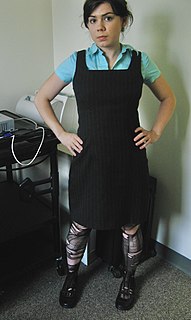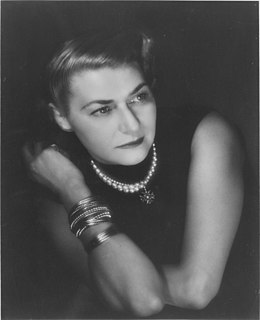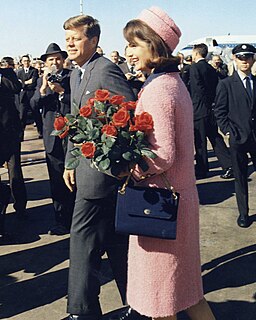
A jumper or jumper dress, pinafore dress or informally pinafore is a sleeveless, collarless dress intended to be worn over a blouse, shirt, T-shirt or sweater. Hemlines can be of different lengths and the type of collar and whether or not there is pleating are also variables in the design.
Preppy or prep is a subculture in the United States associated with old private Northeastern university-preparatory schools. The terms are used to denote a person seen as characteristic of a student or alumnus of these schools. Characteristics of preps in the past include a particular subcultural speech, vocabulary, dress, mannerisms, etiquette, reflective of an upper-class upbringing.

Rudolf "Rudi" Gernreich was an Austrian-born American fashion designer whose avant-garde clothing designs are generally regarded as the most innovative and dynamic fashion of the 1960s. He purposefully used fashion design as a social statement to advance sexual freedom, producing clothes that followed the natural form of the female body, freeing them from the constraints of high fashion.

A blouse is a loose-fitting upper garment that was formerly worn by workmen, peasants, artists, women, and children. It is typically gathered at the waist or hips so that it hangs loosely ("blouses") over the wearer's body. Today, the word most commonly refers to a girl's or woman's dress shirt It can also refer to a man's shirt if it is a loose-fitting style, though it rarely is. Traditionally, the term has been used to refer to a shirt which blouses out or has an unmistakably feminine appearance.

Los Angeles Trade–Technical College is a public community college in Los Angeles, California. It offers academic courses towards 4-year colleges and vocational training programs. It is part of the Los Angeles Community College District and is accredited by the Accrediting Commission for Community and Junior Colleges (ACCJC), Western Association of Schools and Colleges, The American Culinary Federation, and the National League of Nursing among others.

Dana James Hutton was an American actor in film and television best remembered for his role as Ellery Queen in the 1970s TV series of the same name and his screen partnership with Paula Prentiss in four films, starting with Where the Boys Are. He is the father of actor Timothy Hutton.
Walter Scharf was an American film composer.

The 1960s in fashion featured a number of diverse trends. It was a decade that broke many fashion traditions, mirroring social movements during the time. Around the middle of the decade, fashions arising from small pockets of young people in a few urban centres received large amounts of media publicity, and began to heavily influence both the haute couture of elite designers and the mass-market manufacturers. Examples include the mini skirt, culottes, go-go boots, and more experimental fashions, less often seen on the street, such as box-shaped PVC dresses and other PVC clothes.

Fashion in the 1970s was about individuality. In the early 1970s, Vogue proclaimed "There are no rules in the fashion game now" due to overproduction flooding the market with cheap synthetic clothing. Common items included mini skirts, bell-bottoms popularized by hippies, vintage clothing from the 1950s and earlier, and the androgynous glam rock and disco styles that introduced platform shoes, bright colors, glitter, and satin.

Pauline Trigère was a Franco-American couturière. Her award-winning styles reached their height of popularity in the United States during the 1950s and 1960s. Recognized early in her career as an innovator of cut and construction, Trigère brought to women of all ages all over the world such novelties as the jumpsuit, the sleeveless coat, the reversible cape and the embroidered sheer bodice. She reinvented ready-to-wear fashion, matching form to function with bold prints and architectural silhouettes to create a distinctly modern female aesthetic. Trigère’s loyal clients included Grace Kelly, Jacqueline Kennedy Onassis, Elizabeth Taylor, Kay Wiebrecht, and Evelyn Lauder.

A shirtdress is a style of women's dress that borrows details from a man's shirt. These can include a collar, a button front, or cuffed sleeves. Often, these dresses are made up in crisp fabrics including cotton or silk, much like a men's dress shirt would be. As they are typically cut without a seam at the waist, these dresses often have a looser fit, usually relying on a belt to define the waist. Button fronts and a forgiving fit make this a flattering look for most body types.

A poet shirt is a type of shirt made as a loose-fitting blouse with full bishop sleeves, usually decorated with large frills on the front and on the cuffs. Typically, it has a laced-up V-neck opening, designed to pull over the head, but can have a full-length opening fastened by buttons. The collar may be standing or folded over with points. Fabrics commonly used in its manufacture include linen, cotton, satin and velvet, while frills may be of the same fabric or of lace. Originally intended as a male garment, it is also worn by women today.

Harlequin print is a repeating pattern of contrasting diamonds or elongated squares standing on end.
Mary Had a Little… is a 1961 British comedy film directed by Edward Buzzell and starring Agnès Laurent, Hazel Court and Jack Watling. It takes its title from the nursery rhyme Mary Had a Little Lamb and is about a slick impresario who tries unsuccessfully to win a bet with a psychiatrist over the production of a perfect baby via hypnotism.

The 2010s have thus far been defined by hipster fashion, athleisure, a revival of austerity-era period pieces and alternative fashions, unisex early 1990s style elements influenced by grunge and skater fashions. The later years of the decade witnessed the growing importance in the western world of social media influencers paid to promote fast fashion brands on Pinterest and Instagram.

A pink Chanel suit was worn by Jacqueline Bouvier Kennedy on November 22, 1963, when her husband, President John F. Kennedy was assassinated in Dallas, Texas. Made of wool bouclé, the double-breasted, strawberry pink and navy trim collared suit was matched with a trademark matching pink pillbox hat and white gloves. After President Kennedy was assassinated, Jacqueline Kennedy insisted on wearing the suit, stained with his blood, during the swearing-in of Lyndon B. Johnson on Air Force One and for the flight back to Washington, D.C., with the president's body.

A blouson or blouse jacket is a jacket that is drawn tight at the waist, causing it to blouse out and hang over the waistband. Some of them have a hood. It takes most of its modern traits from the American flight jacket and police blouson. It is related to the Eisenhower jacket. It is considered to be both sportswear and casual civilian clothing.

The tam was a millinery design for women based on the tam o' shanter military cap and the beret. Sometimes it was also known as a tam cap or the traditional term tam o'shanter might also be used. It became popular in the early 1920s, when it followed the prevailing trends for closer-fitting hats that suited shorter hairstyles and for borrowing from men's fashion; other traditional men's hats that rose to popularity in women's fashion during this period included the top hat and bowler.

A squaw, fiesta, Kachina, Tohono or patio dress is an American style of dress developed in Arizona. It became popular during the 1940s and 1950s, and many famous women owned these dresses. It was developed primarily by Dolores Gonzales and Cele Peterson, who appropriated the look from Native American fashion. The word "squaw", once used for Native American women and thus for this fashion, is now seen as offensive and the other names for the dress, such as "fiesta" or "patio", are preferred.



















